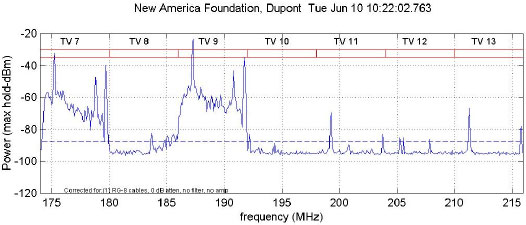


|
||
|
||
Yesterday, the US Federal Communications Commission (FCC) voted to allow qualified devices to operate on a license-exempt basis in unused portions of TV channels 2-51, spectrum commonly referred to as “TV white spaces.” A lot has already been written about this move which was supported by Intel, Google (their related blog post) and others in the White Spaces Coalition, but vilified by TV broadcasters.
What is missing in these discussions is the bigger picture. Almost all radio spectrum is under-utilized and yet, except for a few slivers, it’s all been assigned to someone. Meanwhile today’s radio technology is vastly more efficient than most of what has been licensed. What’s more, we now have the potential to share wireless spectrum in ways that potentially render the whole idea of fixed frequency assignments obsolete. But those who have licenses under the existing regime represent strong vested interests. The only politically acceptable approach is to open up “secondary use” while protecting legacy licensees.
The first step was getting access to the 3650-3700 MHz spectrum, something that happened last year. Yesterday’s move was a much bigger step, because the legacy licensees in the TV bands are so vocal and so well connected in Congress.
Now we need similar access to all the rest of the spectrum!
To elaborate…
Am I too optimistic about TV White Spaces?
Some have complained the white space rules are too restrictive and will never allow the technology to reach it’s promise. But these rules are subject to change as technology improves, as initial fears are overcome and as the growing “secondary use” community gains critical mass and political clout. Such FCC rule changes are routine and are normally completed without the mass of publicity that surrounded yesterday’s decision.
Spectrum under-utilized
Today, almost all radio spectrum has been licensed to someone although most spectrum is unused most of the time, even in major metropolitan areas. Obviously there are a lot of unused TV channels in any one city, as illustrated by these energy measurements in Washington DC’s Dupont Circle:

but most spectrum, particularly from 1 GHz to 10 GHz is under-utilized:

Radio technology has been improving at least as rapidly other electronic technology and yet most spectral assignments were made decades ago and mandate the use of specific technologies that are completely obsolete. What’s worse, it now appears that the whole concept of assigning specific frequencies to specific users was just a result of limitations of early- and mid-20th century technology. Today, and more so in the future, there are orders of magnitude of additional performance that can be obtained from wireless technology. But in almost all cases, new technologies are blocked by existing assignments and their associated vested interests (like the National Association of Broadcasters in the case of TV white spaces).
The visual analogy
To get a sense of the potential, consider the visual spectrum (light waves are just very, very high frequency radio waves). I don’t need a license to turn on a light bulb. No one has licensed the sun. And no one has licensed the lightwave receivers that are our eyes together with our visual cortices. And yet we receive an enormous amount of information visually and we do so despite others in our immediate vicinity operating with exactly the same frequencies. Today’s radio receivers don’t approach the efficiency of the human vision system but we now understand that they could, and presumably will, in due course.
Obtaining secondary access to more spectrum
The technology that has been developed for the 3650 MHz band (see IEEE 802.11y for example) and the technology that is developed for the TV White Spaces, can be reused in other bands. Already there are advocates for license-exempt access (as a secondary use) to the 800 MHz stretch of spectrum from 3400 MHz to 4200 MHz. And, many other bands are candidates for license-exempt secondary use.
Let’s take pleasure in the success in the TV white spaces, but resolve to go after all the white space across all the spectrum.
Sponsored byVerisign

Sponsored byVerisign

Sponsored byWhoisXML API

Sponsored byRadix

Sponsored byIPv4.Global

Sponsored byCSC

Sponsored byDNIB.com
